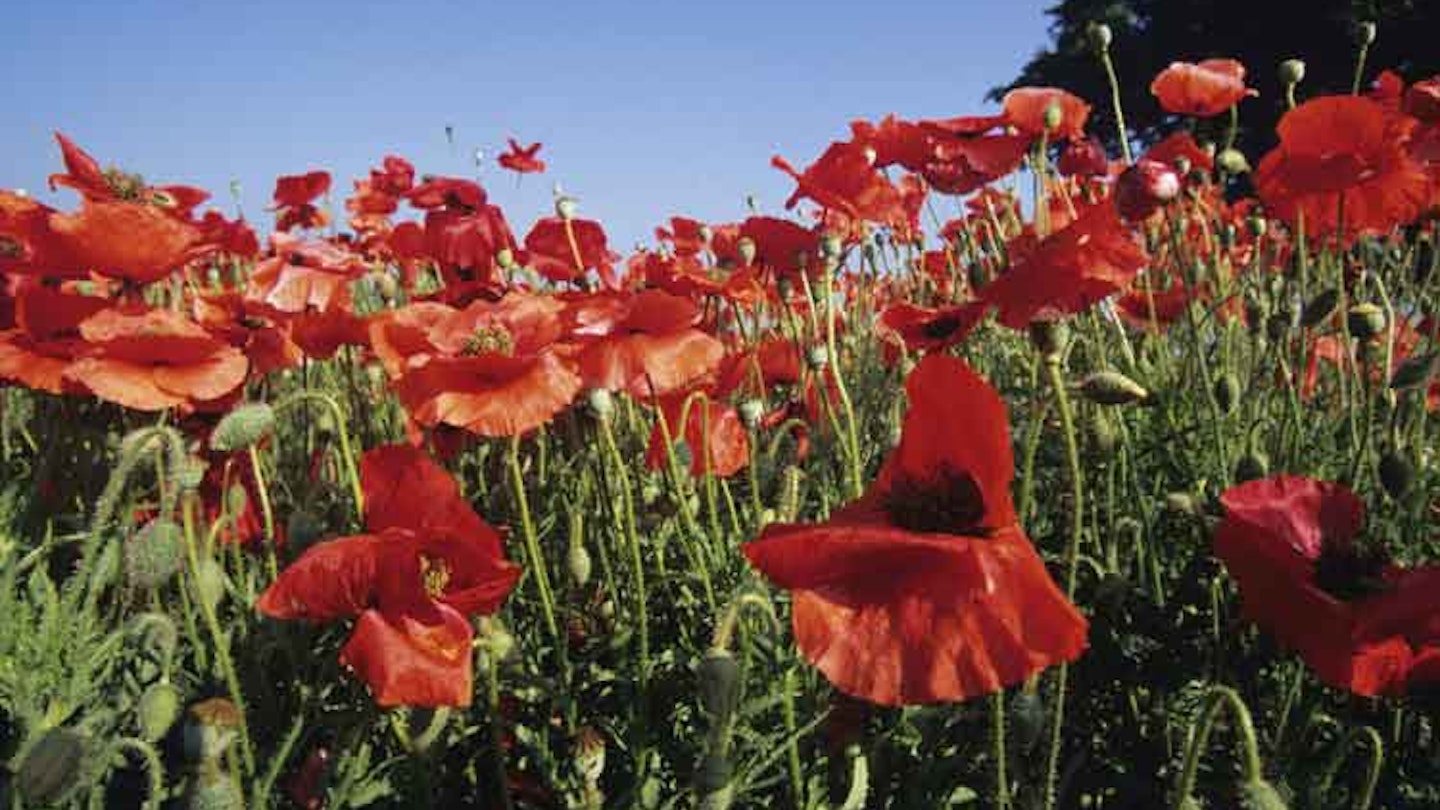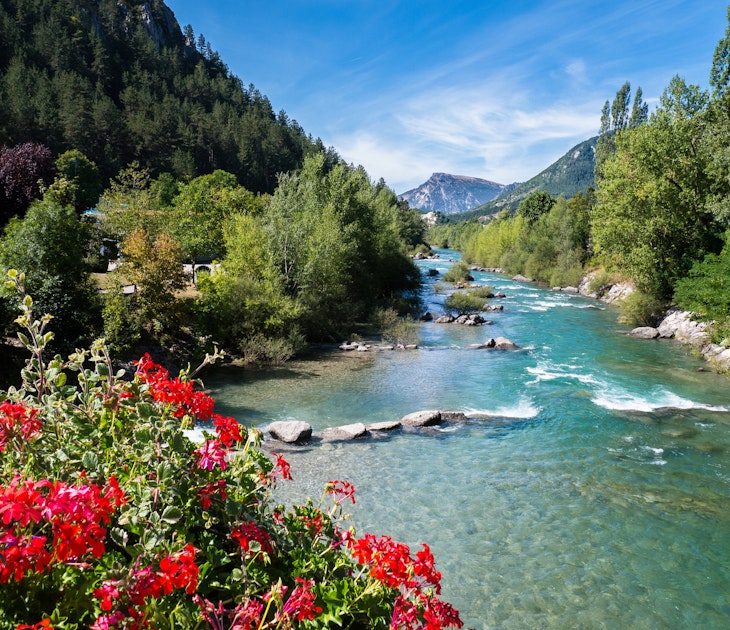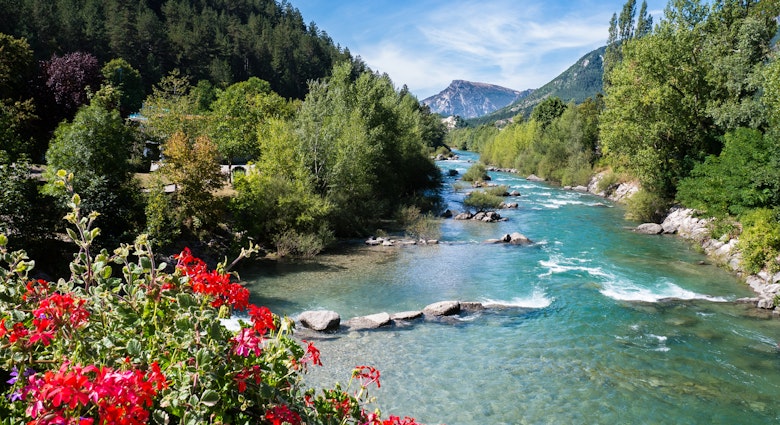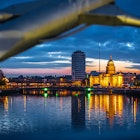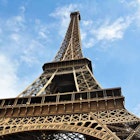2014 marks the centenary of the start of the Great War (28 July 1914 to 11 November 1918). Here are some poignant reminders of this devastating conflict.
A field of wild Flanders poppies. Image by Tom Brakefield / Stockbyte / Getty Images.
Poppy Fields, Flanders, Belgium
‘In Flanders fields the poppies grow; between the crosses, row on row…’ Probably the most celebrated of the WWI poems, these beautifully evocative opening lines were penned by a Canadian Lieutenant Colonel, John McCrae, in homage to a lost friend. As war ravaged the countryside and churned the earth, the disturbance stimulated the growth of poppies; they illuminated the countryside and have since become the defining image of remembrance to the dead. The poppies still bloom each year, providing nature’s own homage to the bravery of those who made the greatest sacrifice.
Poppies are in bloom on the Western Front battlefields from April to early July, but unseasonal weather can affect their growth.
Gallipoli, Turkey
Away from northern Europe’s front lines, some of the fiercest fighting occurred at Gallipoli. This eight-month campaign proved disastrous for Allied forces – some 34,000 Brits, Aussies and Kiwis perished here. The Gallipoli peninsula is 240km southwest of İstanbul, flanked by the Aegean Sea on one side and the Dardanelles channel on the other. The Allied plan was simple – send a flotilla up the Dardanelles to seize control of İstanbul and open a naval passage to Russia. But Ottoman troops provided unflinching resistance that forced the Allies to withdraw.
Trooper Tours (www.troopertours.com) will take you around the key sites in Gallipoli.
Graves of British WWI soldiers at Tyne Cot British Military Cemetery. Image by Dennis K Johnson / Lonely Planet Images / Getty Images.
Tyne Cot Cemetery, Zonnebeke, Belgium
Of all the Commonwealth cemeteries marking the fallen heroes of WWI, Tyne Cot is the largest, containing 11,954 graves of soldiers from the UK, Canada, Australia, New Zealand, South Africa and the West Indies. The cemetery also carries the names of a further 35,000 soldiers who were never found. At the centre of the graves, the Commonwealth Cross of Sacrifice stands atop a German pillbox, overlooking row upon row of white headstones. There’s no more powerful introduction to the sorrow of war.
Zonnebeke is 75km south of Bruges. Combine a visit to Tyne Cot with a trip to the Memorial Museum Passchendaele 1917 (www.passchendaele.be).
Christmas Truce Memorial, Frelinghien, France
Amid the horror of front-line fighting, stories of simple humanity have become legend; none more so than the Christmas Truce of 1914. With the war still in its infancy, hundreds of Allied and German soldiers near the French town of Frelinghien downed their guns on Christmas Day and engaged in a remarkable truce. Official records are sketchy but the most famous story recollects a football match on the battlefield – nobody has been able to corroborate this, but enough evidence of the truce exists for it to be marked with a plaque at the edge of the village.
Frelinghien is 90km southwest of Calais; combine it with a visit to Ieper, 15km north.
Menin Gates in Ieper, Belgium. Image by Dennis K Johnson / Lonely Planet Images / Getty Images.
Menin Gate Memorial, Ieper, Belgium
The battlefields around Ypres saw appalling conflict. At the eastern end of town stands Menin Gate, a memorial to more than 54,000 soldiers whose final resting place remains unknown. Every evening at 8pm, the road beneath the arch is closed to traffic and buglers from the local fire brigade sound the Last Post, the haunting commemoration to soldiers lost in war. On summer evenings the event draws large crowds who stand silent in remembrance; in the bleak winter, the bugle notes drift away in the wind.
Ypres is now known by its Flemish name, Ieper. Menin Gate is close to the marketplace.
Wilfred Owen’s Grave, Ors, France
Wilfred Owen was a British poet and one of WWI’s most celebrated voices. He enlisted in October 1915, and his work was influenced both by battlefield trauma and the writing of his friend, Siegfried Sassoon. His poems are regarded as the finest records of firsthand experience – Anthem for Doomed Youth is among the most famous. Owen was killed one week before Armistice Day – the telegram informing his mother was delivered amid victory celebrations – and his grave can be found in the Ors Communal Cemetery.
The village of Ors lies between Le Cateau and Landrecies, 85km southeast of Lille.
The Latin Bridge in Sarajevo. Image by Andrew Burke / Lonely Planet Images / Getty Images.
Latin Bridge, Sarajevo, Bosnia & Hercegovina
When Archduke Franz Ferdinand of Austria was assassinated in Sarajevo on 28 June 1914, few would have imagined the carnage that would follow. Ferdinand was targeted by a revolutionary movement known as Young Bosnia, and his death was the catalyst that led Austria-Hungary to declare war on Serbia. Germany, allied to Austria-Hungary, soon joined the fold. The spot of Ferdinand’s death was close to the Latin Bridge in the heart of the city, and a small plaque commemorates the event. There’s no fuss and precious little pomp, but for budding historians a visit here forms part of the ultimate WWI pilgrimage.
Sarajevo is one of Europe’s up-and-coming cities, so you can combine your history fix with top shopping and entertainment.
Armistice Glade, Rethondes, France
11 November 1918; the end of the Great War. After four long years, and with Europe on its knees, Germany accepted the armistice conditions proposed by the Allies. Under the command of Marshal Ferdinand Foch of the French Army, the selected congressmen assembled to sign the treaty. The location Foch chose was the carriage of his personal train, secluded in the tranquil forest of Compiègne. Today the forest hides a glade with a war memorial, under the gaze of Foch’s statue. Alongside lies a reconstruction of the Armistice Carriage – the original was seized by Nazi troops in WWII and destroyed in 1945.
The Armistice Glade lies between Rethondes and Compiègne (route D546). Trains (www.sncf.com) run from Paris Nord to Compiègne.
Trench of Death, Diksmuide, Belgium
The Western Front was a trench network covering thousands of kilometres, extending south from Nieuwpoort on the Belgian coast to the French border with Switzerland. Bitterly cold, waterlogged and thick with mud, the trenches offered soldiers precious little protection. In the countryside, 1.5km from the town of Diksmuide, a small section has been preserved. Known as the ‘Trench of Death’, conservation work ensures that this remains a unique example of battlefield life.
The Trench of Death is 45km southwest of Bruges, which makes a good base for exploring other battlefields and cemeteries.
Lochnagar Crater, La Boisselle, France
The five-month-long Battle of the Somme was one of WWI’s defining battles, with more than a million dead. Yet few know that its roots lay deep beneath the battlefield. In an attempt to outfox the Germans, British troops started the offensive by blowing them up from below. Tunnelling teams laid 10 huge mines under enemy lines, detonating them simultaneously. Stuffed with 28.8 tonnes of explosives, the assault gave the Allies an advantage in the battle. The massive crater (90m across, 30m deep) can still be seen.
La Boisselle is 155km north of Paris. From the village, follow the signs for ‘La Grande Mine’.
Seek out the world's most thought-provoking sights with Lonely Planet's Best in Travel 2014.
